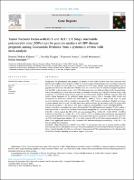Tumor Necrosis Factor-α-863C/A and 1031 T/C Single nucleotide polymorphic sites (SNPs) may be putative markers of HBV disease prognosis among Caucasoids: Evidence from a systematic review with meta-analysis

View/
Date
2022-01-19Author
Mukasa Kafeero, Hussein
Ndagire, Dorothy
Ocama, Ponsiano
Walusansa, Abdul
Sendagire, Hakim
Metadata
Show full item recordAbstract
Background: The pathogenesis and prognosis of hepatitis B virus (HBV) infection have been correlated with
genetic polymorphisms in the gene loci within the promoter region of the immune system modulator molecules
such as the cytokines including the tumor necrosis factor (TNF)-alpha. Besides, these polymorphisms vary at
population levels but it is not conclusive whether races are involved or not. We aimed at testing the hypothesis
that the SNPs in the promoter region of the TNF-alpha gene may have different effects in the Caucasoid populations
by pooling the odds of association with the clearance/increased risk of the HBV infection from a large
sample size obtained from many primary studies. We searched Scopus, PubMed, EMBASE, Cochrane, Willy and
Google scholar databases for the published studies between January 1998 to December 2020. Studies that
investigated the association between the TNF-α-238G/A, -308G/A, -857C/T, -863C/A and -1031 T/C gene
promoter polymorphisms with the resolution/increased risk of HBV infection published in English and in peer
reviewed journals were included. The odds ratios were used to evaluate the association of the TNF-α-gene SNPs
with the risk/resolution of the disease. This study is registered on PROSPERO, number CRD42021266944.
Results: A significant association was observed between the TNF-α-857 homozygous mutation TT and its allele T
with reduced risk of infection or resolution of the disease among both the Caucasoids and the Mongoloids (p <
0.05, OR < 1.0). In contrast, the TNF-α-1031 wild type genotypes TT; p = 0.001, OR = 0.634, 95%CI = [0.489 to
0.822%] and its allele T; p = 0.001, OR = 0.701, 95%CI = [0.571 to 0.860%] were significantly associated with
reduced risk of infection or increased chances of resolution of the disease among the Caucasoids only. However,
the TNF-α-863 homozygous mutation AA or its allele A and the TNF-α-1031 heterozygous mutation CT or the
allele C were significantly associated with unresolved HBV infection among the Caucasoids (p < 0.05, OR > 1.0)
but not among the Mongoloids.
Conclusion: Tumor Necrosis Factor-α-863C/A and 1031 T/C polymorphic sites may be putative markers of HBV
disease prognosis and pathogenesis among the Caucasoid populations but not among the Mongoloid populations.
Future research therefore should focus on the role of these presumed TNF-α-polymorphisms in the clinical profile
of the HBV infections targeting an African or Negroid population.
Collections
- Research Papers [57]
